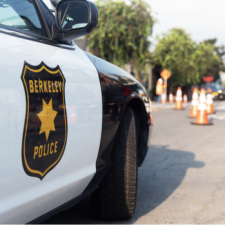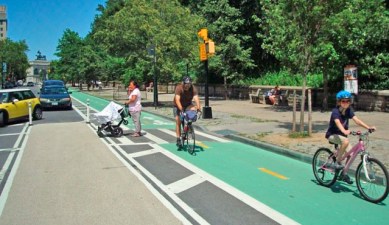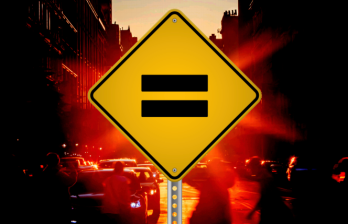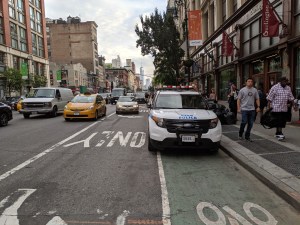Vision Zero Cities: Removing Police from Traffic Enforcement Is Crucial — and Hard!
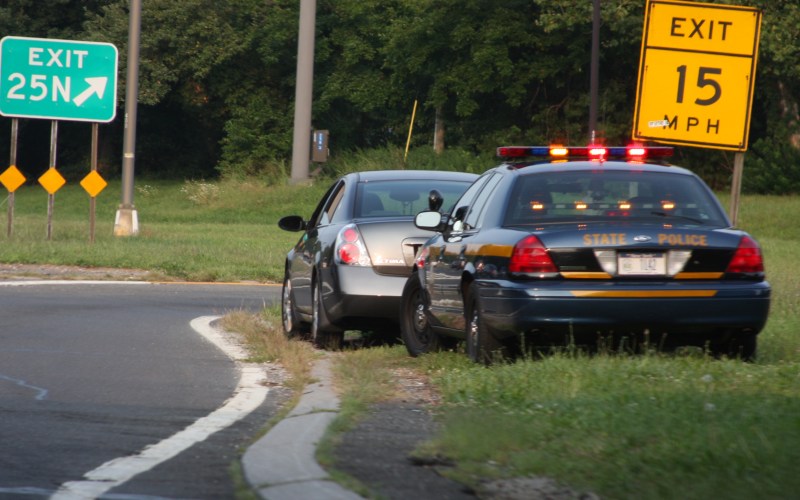
It will take more than just political will to remove police from traffic enforcement — it will take a commitment to redesigning streets for safety so that there is no need for imperfect human beings to enforce driving rules, a policy that has led to Black and brown New Yorkers to suffer disproportionately from police bias and brutality.
Five experts on Tuesday’s “Self-Enforcing Streets: Improving Safety and Reducing the Harm of Racial Bias” panel at year’s all-digital Transportation Alternatives’ Vision Zero Cities conference made it clear that cities can — and should — move past the current system of police-overseen traffic enforcement because it will be better for safety as well as remove a major racial flashpoint.
The discussion followed a report last month from Attorney General Letitia James, who recommended that police cease conducting traffic stops — a recommendation that came after a Transportation Alternatives, with support from eight local pols and a local community board, demanded the de Blasio Administration boot the NYPD from traffic enforcement in favor of automated enforcement and redesigned streets.
But how could such a thing be achieved? Here are the highlights from the panel.
What would a city without cops enforcing traffic look like?
The first problem is that our cities currently have infrastructure that caters solely to car drivers, not pedestrians and vulnerable road users, said Dongho Chang, a city traffic engineer in Seattle. So before cities can move away from police enforcement, they must redesign streets and install automated enforcement systems such as light cameras, bus lane cameras, and speed cameras.
“Our cities are built in an auto-centric way and because of the infrastructure we have in place it will take time. We need automated enforcement until the infrastructure is in place to self enforce,” said Chang.
Replacing cops’ discretionary traffic stops with automated enforcement and street redesigns will create more equitable cities, according to Shayana Kadidal, of the Center for Constitutional Rights.
“Over reliance on law enforcement to address social problems that are too minor to require intervention by armed officers facilitates violent encounters, like traffic enforcement and loose cigarettes,” said Kadidal. “Self enforcement, engineering physical streets, make enforcement equitable.”

What that would it mean for vulnerable road users, and people of color?
Removing cops from traffic enforcement will take away the discretionary stops that can lead to police brutality — and instead, the city can reinvest those resources into additional efforts to physically keep vulnerable road users safe, according to Manhattan Council Member Carlina Rivera.
“When we invest in safe streets, we save money by reducing the need for police-led traffic enforcement. There’s been a nationwide reckoning with law enforcement, our budget gives us an opportunity to lead with rebalancing and reinvesting,” said Rivera. “Daylighting, barriers at intersections can do a lot more to keep New York City safe than I think an officer ever would.”
Streetsblog has reported on the discriminatory enforcement against people of color on bikes, in cars, and just walking on two feet — a whopping 99 percent of the jaywalking tickets cops issued during the first quarter of this year went to Black and Hispanic people; and of the 440 tickets police issued to people for biking on the sidewalk in 2018 and 2019, 374 — or 86.4 percent — of those where race was listed went to Black and Hispanic New Yorkers.
Cops are 40 percent more likely to stop a Black driver than a white driver, studies show, many of which have led to police brutality and death. And this week, Newsday reported that Suffolk County police are much more likely to search the cars of Black and brown drivers than they are to search vehicles driven by Whites.
It’s a nationwide problem. In 2015, 28-year-old Sandra Bland suspiciously died after police arrested her during a traffic stop that began after she allegedly failed to signal a lane change in Texas; in 2013 in New York City, 23-year-old Sean Bell was shot and killed by police who fired 50 shots into his car; this past May, 28-year-old Maurice Gordon was shot and killed by a state trooper in New Jersey during a traffic stop; and in 2016, 32-year-old Philando Castile was shot and killed by a cop during a traffic stop in Minnesota.
“How many names have we chanted at Black Lives Matter protests that came from traffic stops?” said Kadidal.
What have some cities done?
In Seattle, Chang said, transportation planners there transformed a speedway-style street into a play space for kids, entirely removing the opportunity for speeding.
“There was racing going on and we turned it into a playground,” he said.
Seattle also lowered the speed limit on hundreds of miles of streets in conjunction with installing traffic circles, which physically prevented drivers from speeding on local roads — changes that cut speeding by 97 percent, said Chang.
“Where vehicle and vehicle interactions, and pedestrian interactions, if thoughtfully addressed at the intersection can dramatically impact safety,” he said.

And in D.C., after the city installed a neck-down on one street where a man was killed by a driver while jogging, the results were illuminating. Before installing the traffic-calming measure, drivers were found to yield only about 60 percent of the time. But after it was installed, about 90 percent of drivers were yielding, according to Linda Bailey, of the District Department of Transportation.
“There was a significant improvement in safety at the intersection, said Bailey. “Need to redesign things, sometimes it takes time. We see it as a bridge to getting there as opposed to an end state.”
People often make bad decisions, like biking on the sidewalk, when they feel the alternative is too dangerous. But creating safer bike infrastructure eliminates both the need for would eliminate the need to go on the sidewalk, said Matt Roe of NACTO.
“It’s impossible to make a good decision if infrastructure doesn’t let you,” said Roe. “If we want transportation justice we have to invest in it.”
What are the main barriers?
The biggest hold-up, says Rivera, is “political will.”

Rivera said that many of her colleagues don’t view transportation as a priority, which then trickles down to what gets funded or not.
“Sometimes it takes a tragedy to get conversations going. I come at it from a holistic comprehensive approach, with an intersectional lens of structural racism and how we protect the everyday person, whether a pedestrian or cyclist.”
An example of that came from Mayor de Blasio, when he was initially opposed to the city’s now-successful and permanent summer open streets program that was created to allow for socially distance recreation during the COVID-19 pandemic. That program now includes open streets for restaurants and schools.
At first, de Blasio refused to separate the need for police presence and enforcement from keeping people safe. But safe-street advocates argued that armed officers patrolling open streets would not make anyone safer.
“It was originally opposed by our mayor because of the perceived added strain on NYPD,” Rivera said. “It proved critical to our economy, open streets eventually lead to restaurants and schools. That was always the vision when I first proposed it, and making sure in taking back our streets we proved we do not need increased effort from law enforcement.”
And Roe added that making sure that life-saving transportation projects are funded is the biggest obstacle he sees on a national level.
“We need to keep pumping money into current infrastructure and into making streets safer,” he said.
TransAlt’s Vision Zero Cities conference continues online through Oct. 23. For info, click here.
